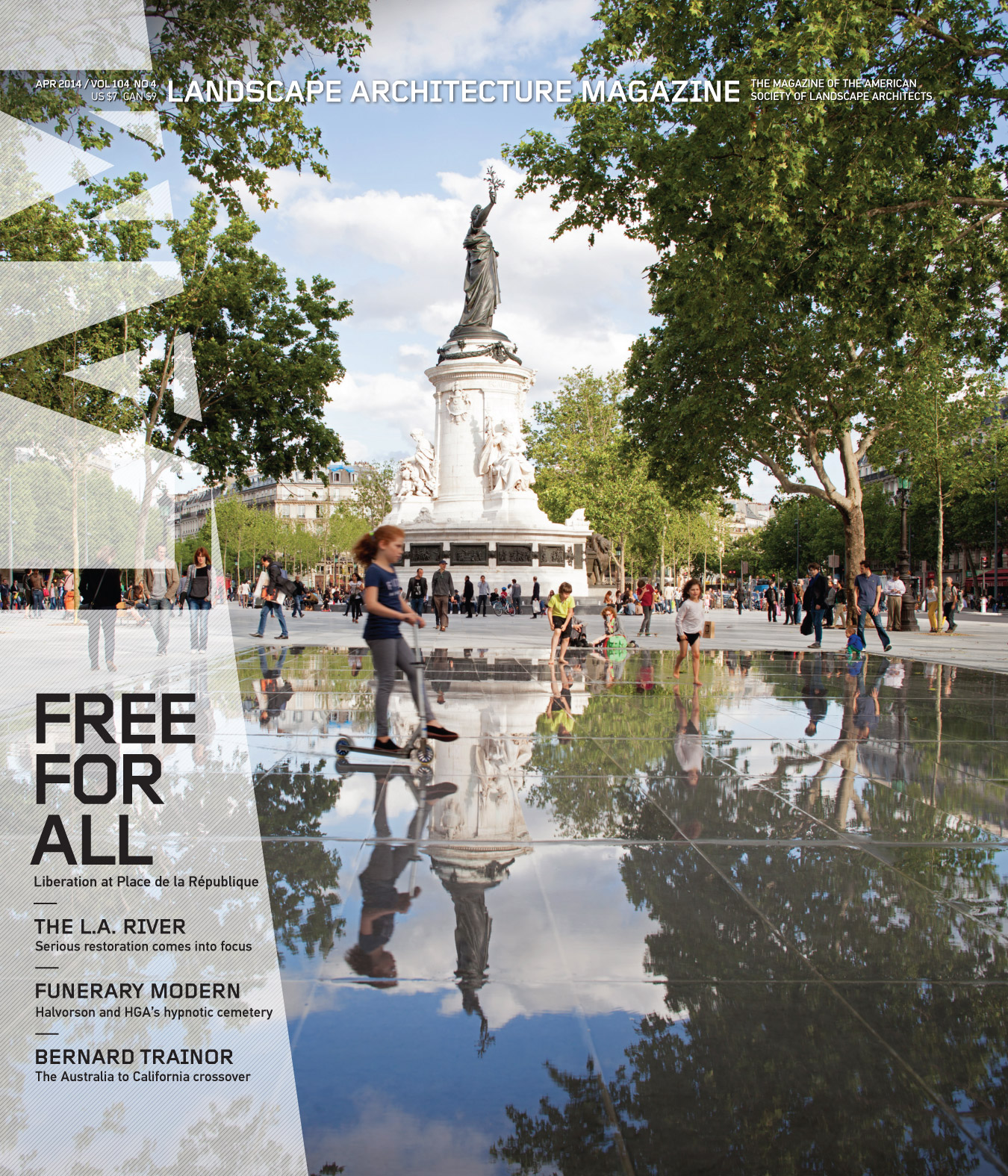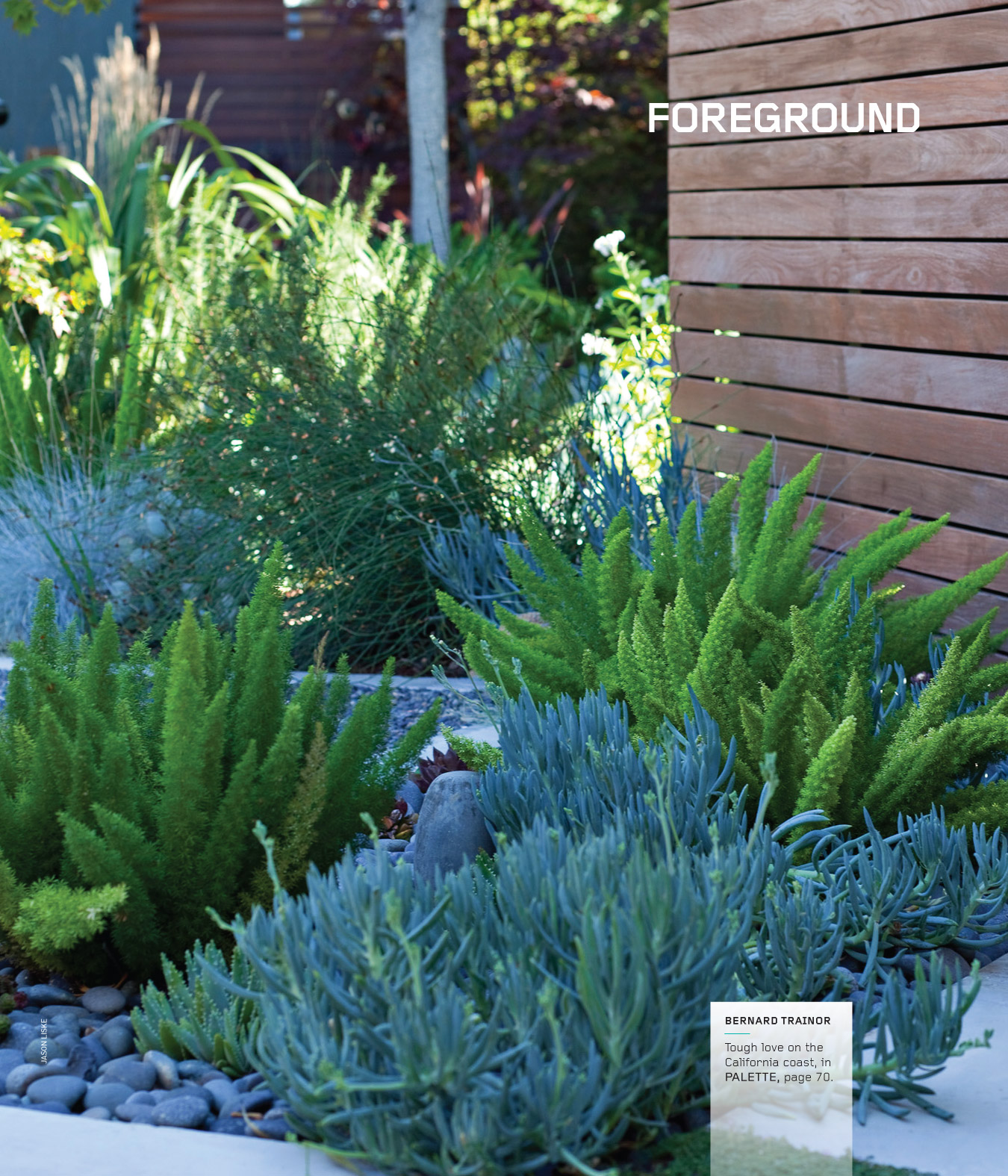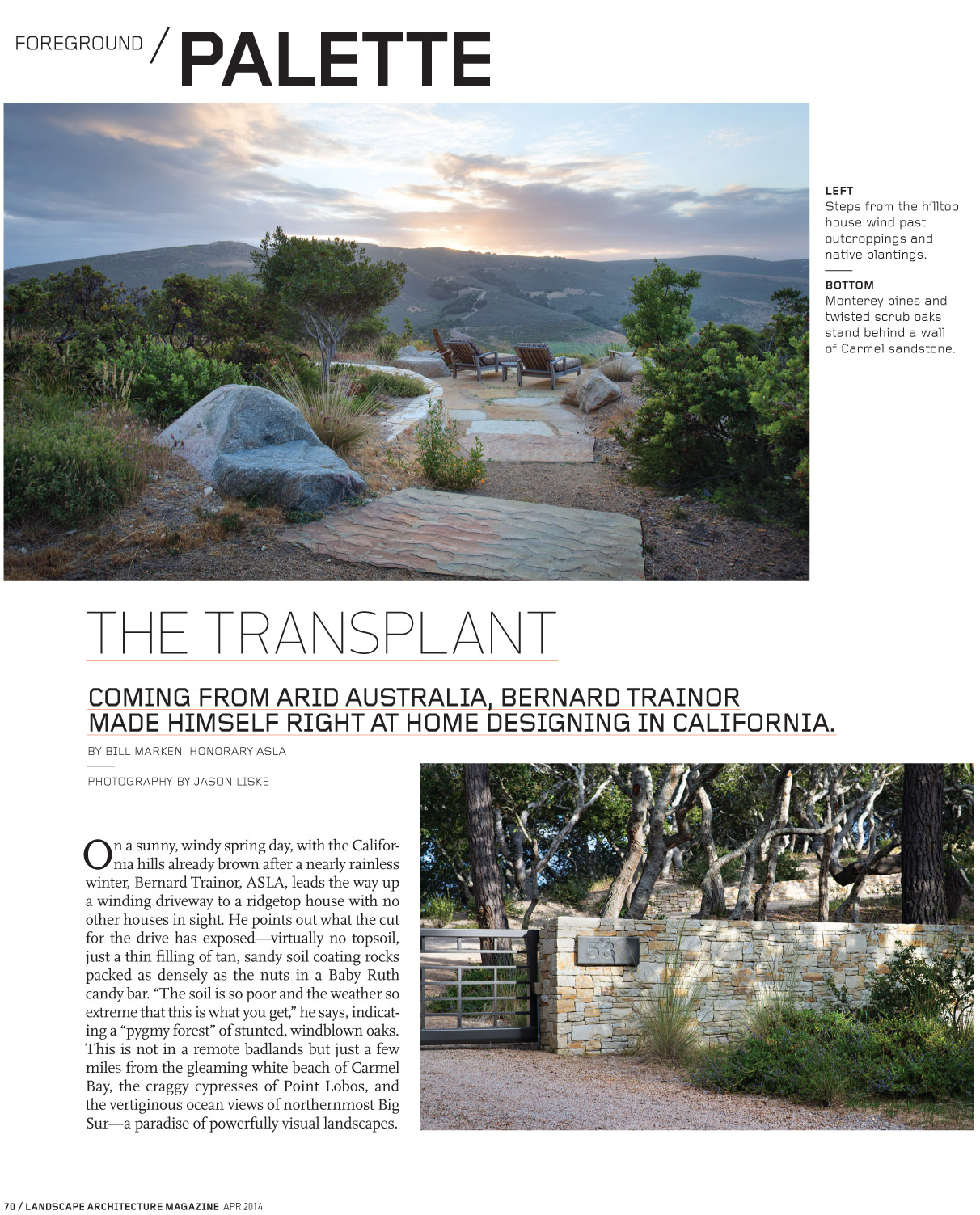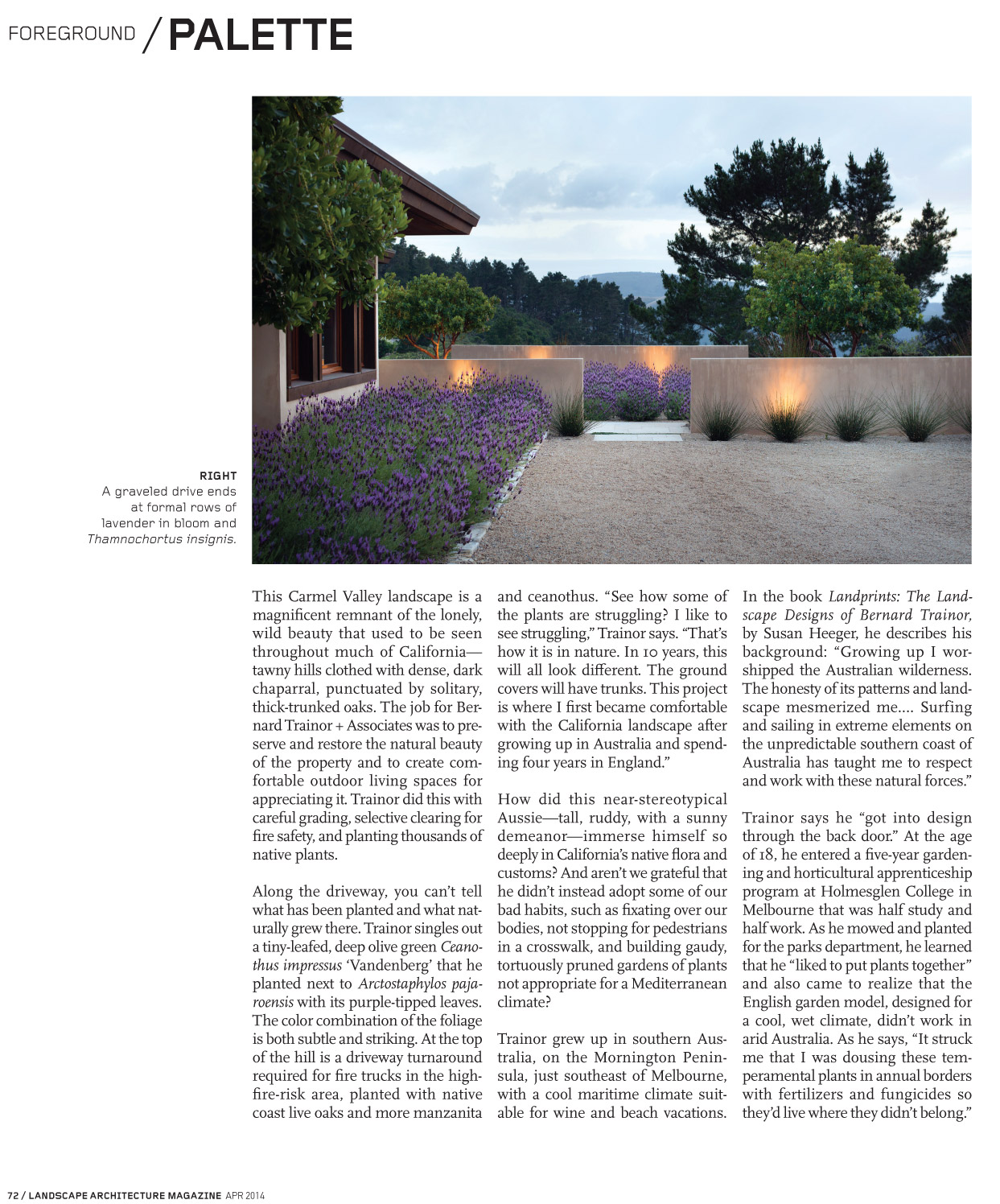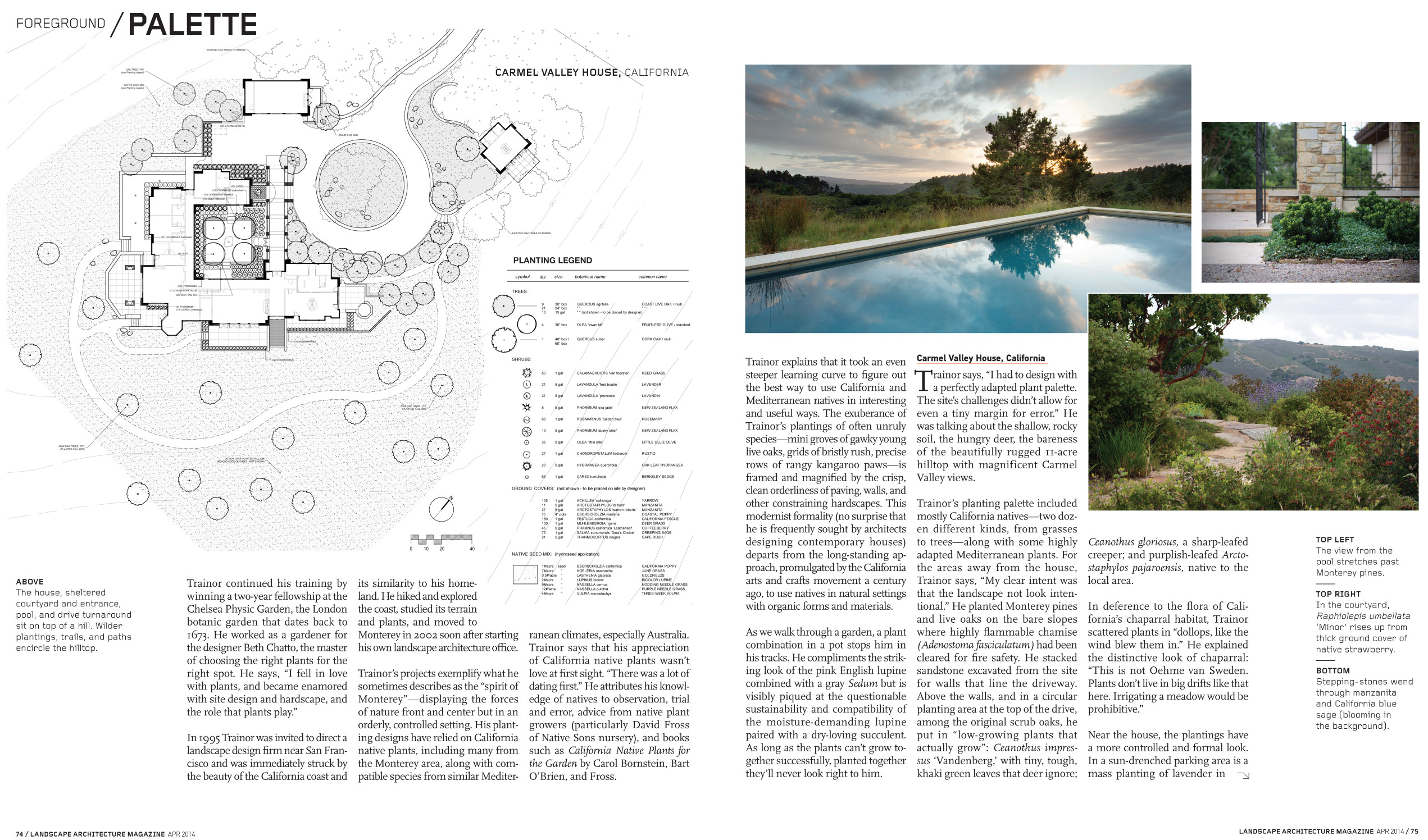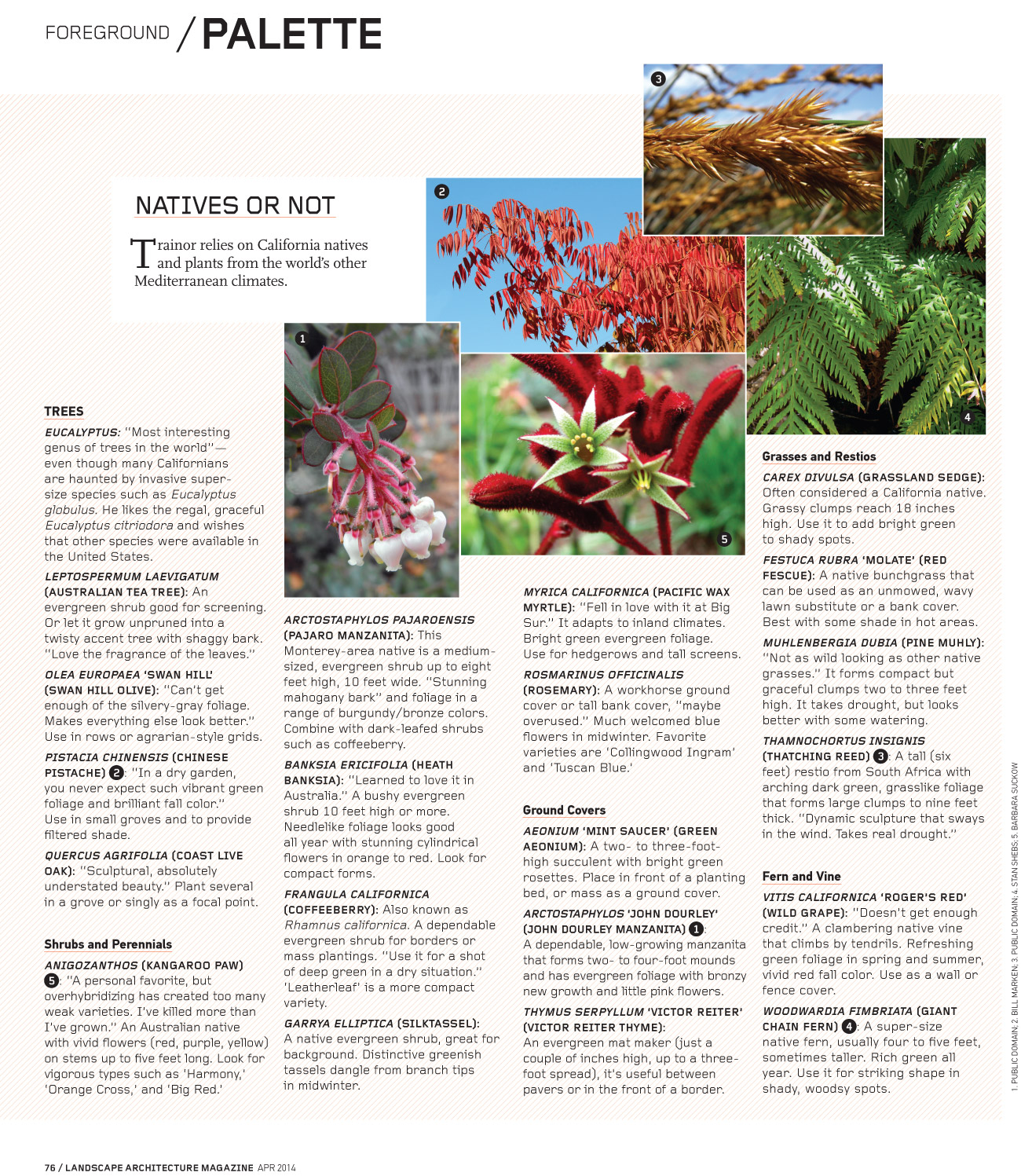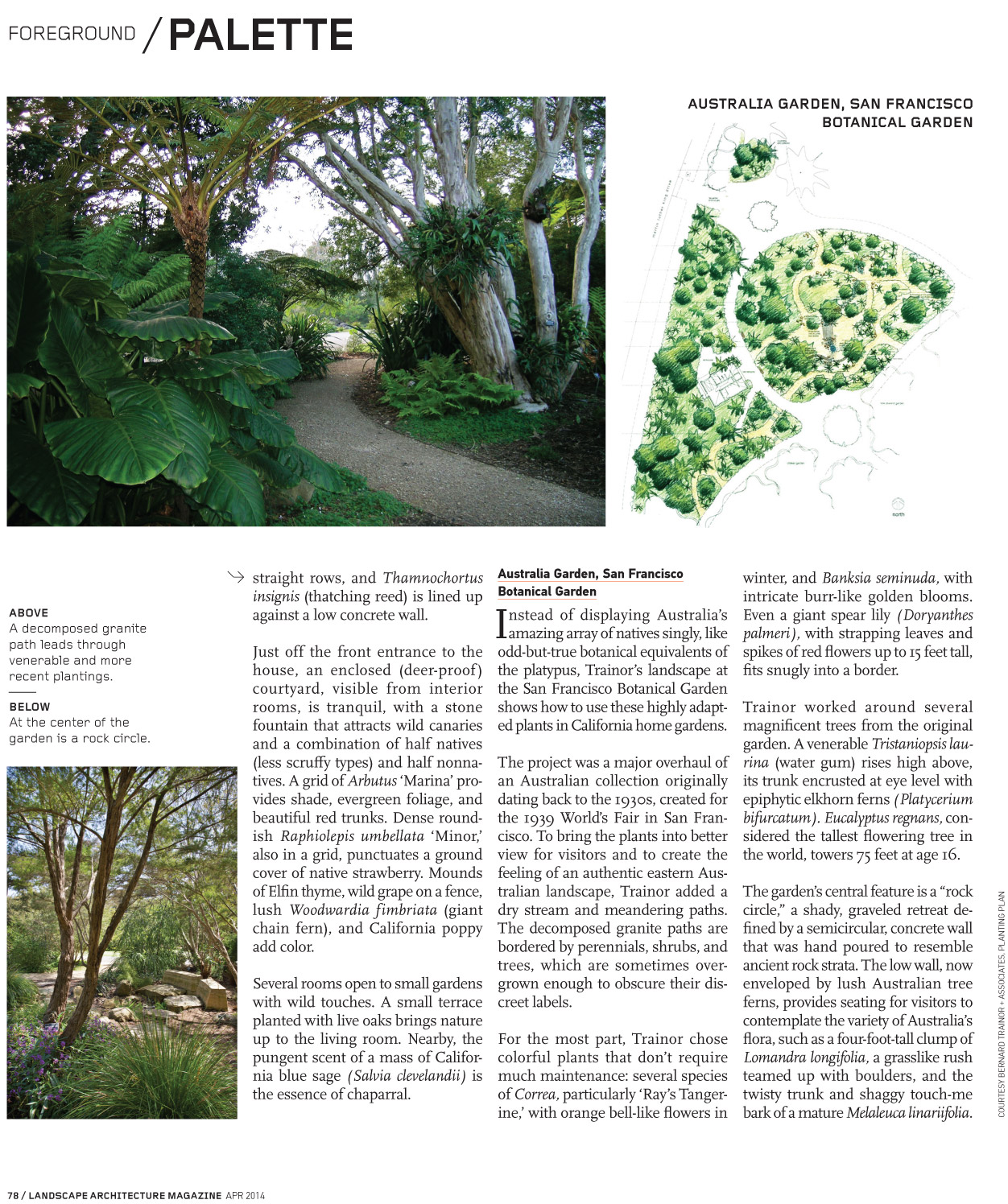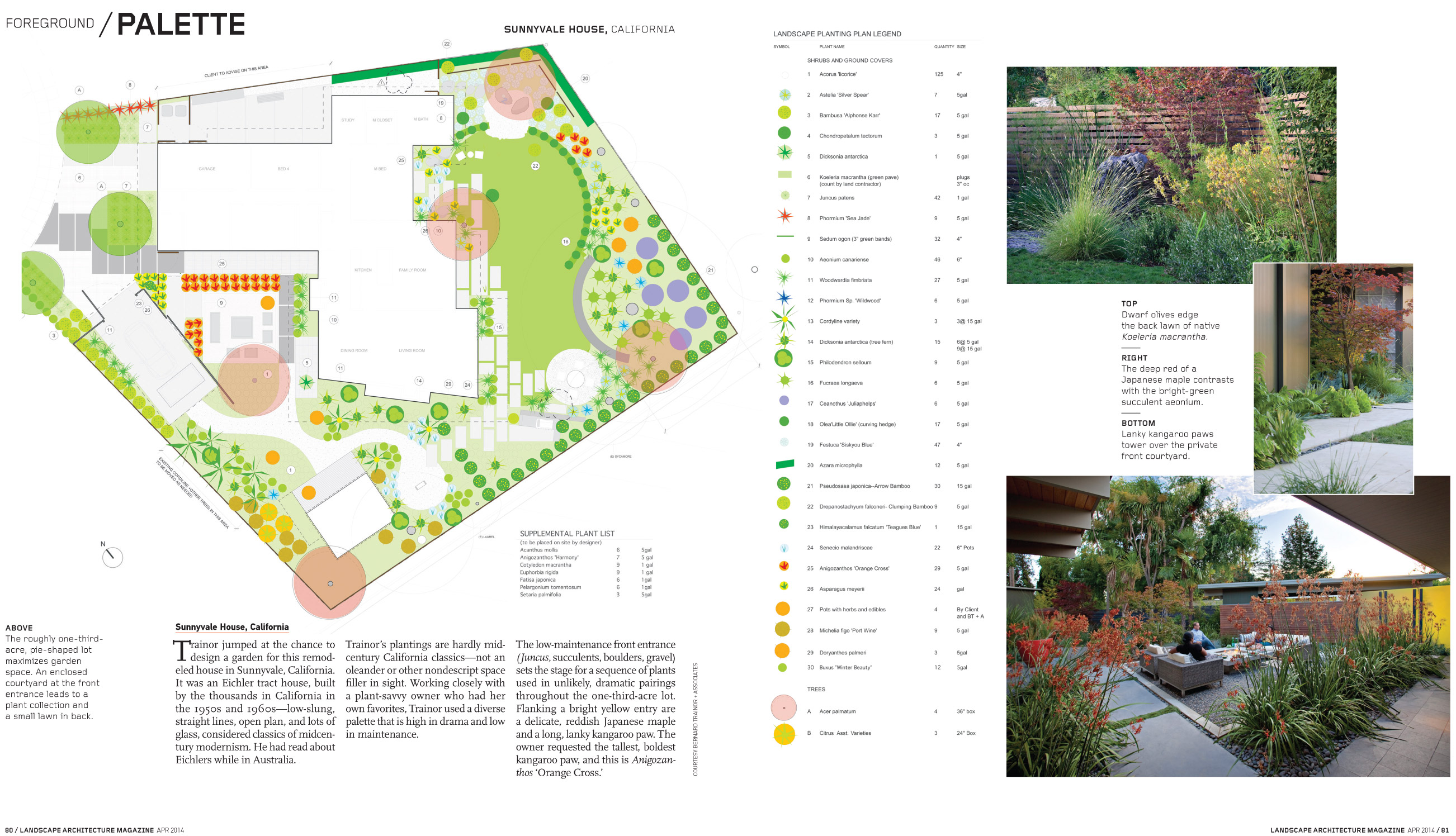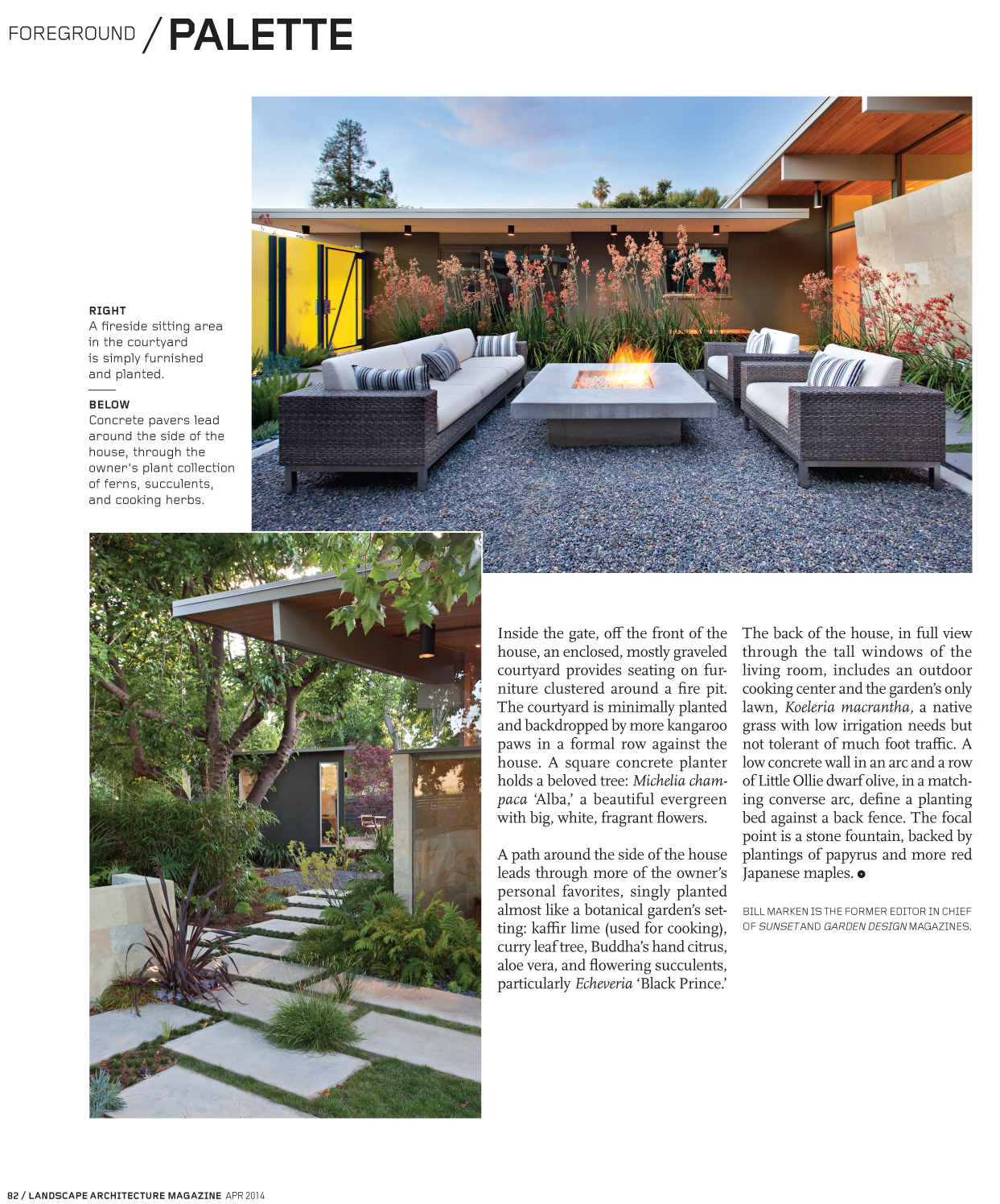On a sunny, windy spring day, with the California hills already brown after a nearly rainless winter, Bernard Trainor, ASLA, leads the way up a winding driveway to a ridgetop house with no other houses in sight. He points out what the cut for the drive has exposed—virtually no topsoil, just a thin filling of tan, sandy soil coating rocks packed as densely as the nuts in a Baby Ruth candy bar. “The soil is so poor and the weather so extreme that this is what you get,” he says, indicating a “pygmy forest” of stunted, windblown oaks. This is not in a remote badlands but just a few miles from the gleaming white beach of Carmel Bay, the craggy cypresses of Point Lobos, and the vertiginous ocean views of northernmost Big Sur—a paradise of powerfully visual landscapes.
This Carmel Valley landscape is a magnificent remnant of the lonely, wild beauty that used to be seen throughout much of California—tawny hills clothed with dense, dark chaparral, punctuated by solitary, thick-trunked oaks. The job for Bernard Trainor + Associates was to preserve and restore the natural beauty of the property and to create comfortable outdoor living spaces for appreciating it. Trainor did this with careful grading, selective clearing for fire safety, and planting thousands of native plants.
Along the driveway, you can’t tell what has been planted and what naturally grew there. Trainor singles out a tiny-leafed, deep olive green Ceanothus impressus ‘Vandenberg’ that he planted next to Arctostaphylos pajaroensis with its purple-tipped leaves. The color combination of the foliage is both subtle and striking. At the top of the hill is a driveway turnaround required for fire trucks in the high-fire-risk area, planted with native coast live oaks and more manzanita and ceanothus. “See how some of the plants are struggling? I like to see struggling,” Trainor says. “That’s how it is in nature. In 10 years, this will all look different. The ground covers will have trunks. This project is where I first became comfortable with the California landscape after growing up in Australia and spending four years in England.”
How did this near-stereotypical Aussie—tall, ruddy, with a sunny demeanor—immerse himself so deeply in California’s native flora and customs? And aren’t we grateful that he didn’t instead adopt some of our bad habits, such as fixating over our bodies, not stopping for pedestrians in a crosswalk, and building gaudy, tortuously pruned gardens of plants not appropriate for a Mediterranean climate?
Trainor grew up in southern Australia, on the Mornington Peninsula, just southeast of Melbourne, with a cool maritime climate suitable for wine and beach vacations. In the book Landprints: The Landscape Designs of Bernard Trainor, by Susan Heeger, he describes his background: “Growing up I worshipped the Australian wilderness. The honesty of its patterns and landscape mesmerized me.… Surfing and sailing in extreme elements on the unpredictable southern coast of Australia has taught me to respect and work with these natural forces.”
Trainor says he “got into design through the back door.” At the age of 18, he entered a five-year gardening and horticultural apprenticeship program at Holmesglen College in Melbourne that was half study and half work. As he mowed and planted for the parks department, he learned that he “liked to put plants together” and also came to realize that the English garden model, designed for a cool, wet climate, didn’t work in arid Australia. As he says, “It struck me that I was dousing these temperamental plants in annual borders with fertilizers and fungicides so they’d live where they didn’t belong.”
Trainor continued his training by winning a two-year fellowship at the Chelsea Physic Garden, the London botanic garden that dates back to 1673. He worked as a gardener for the designer Beth Chatto, the master of choosing the right plants for the right spot. He says, “I fell in love with plants, and became enamored with site design and hardscape, and the role that plants play.”
In 1995 Trainor was invited to direct a landscape design firm near San Francisco and was immediately struck by the beauty of the California coast and its similarity to his homeland. He hiked and explored the coast, studied its terrain and plants, and moved to Monterey in 2002 soon after starting his own landscape architecture office.
Trainor’s projects exemplify what he sometimes describes as the “spirit of Monterey”—displaying the forces of nature front and center but in an orderly, controlled setting. His planting designs have relied on California native plants, including many from the Monterey area, along with compatible species from similar Mediterranean climates, especially Australia. Trainor says that his appreciation of California native plants wasn’t love at first sight. “There was a lot of dating first.” He attributes his knowledge of natives to observation, trial and error, advice from native plant growers (particularly David Fross of Native Sons nursery), and books such as California Native Plants for the Garden by Carol Bornstein, Bart O’Brien, and Fross.
Trainor explains that it took an even steeper learning curve to figure out the best way to use California and Mediterranean natives in interesting and useful ways. The exuberance of Trainor’s plantings of often unruly species—mini groves of gawky young live oaks, grids of bristly rush, precise rows of rangy kangaroo paws—is framed and magnified by the crisp, clean orderliness of paving, walls, and other constraining hardscapes. This modernist formality (no surprise that he is frequently sought by architects designing contemporary houses) departs from the long-standing approach, promulgated by the California arts and crafts movement a century ago, to use natives in natural settings with organic forms and materials.
As we walk through a garden, a plant combination in a pot stops him in his tracks. He compliments the striking look of the pink English lupine combined with a gray Sedum but is visibly piqued at the questionable sustainability and compatibility of the moisture-demanding lupine paired with a dry-loving succulent. As long as the plants can’t grow together successfully, planted together they’ll never look right to him.
Carmel Valley House, California
Trainor says, “I had to design with a perfectly adapted plant palette. The site’s challenges didn’t allow for even a tiny margin for error.” He was talking about the shallow, rocky soil, the hungry deer, the bareness of the beautifully rugged 11-acre hilltop with magnificent Carmel Valley views.
Trainor’s planting palette included mostly California natives—two dozen different kinds, from grasses to trees—along with some highly adapted Mediterranean plants. For the areas away from the house, Trainor says, “My clear intent was that the landscape not look intentional.” He planted Monterey pines and live oaks on the bare slopes where highly flammable chamise (Adenostoma fasciculatum) had been cleared for fire safety. He stacked sandstone excavated from the site for walls that line the driveway. Above the walls, and in a circular planting area at the top of the drive, among the original scrub oaks, he put in “low-growing plants that actually grow”: Ceanothus impressus ‘Vandenberg,’ with tiny, tough, khaki green leaves that deer ignore; Ceanothus gloriosus, a sharp-leafed creeper; and purplish-leafed Arctostaphylos pajaroensis, native to the local area.
In deference to the flora of California’s chaparral habitat, Trainor scattered plants in “dollops, like the wind blew them in.” He explained the distinctive look of chaparral: “This is not Oehme van Sweden. Plants don’t live in big drifts like that here. Irrigating a meadow would be prohibitive.”
Near the house, the plantings have a more controlled and formal look. In a sun-drenched parking area is a mass planting of lavender in straight rows, and Thamnochortus insignis (thatching reed) is lined up against a low concrete wall.
Just off the front entrance to the house, an enclosed (deer-proof) courtyard, visible from interior rooms, is tranquil, with a stone fountain that attracts wild canaries and a combination of half natives (less scruffy types) and half nonnatives. A grid of Arbutus ‘Marina’ provides shade, evergreen foliage, and beautiful red trunks. Dense roundish Raphiolepis umbellata ‘Minor,’ also in a grid, punctuates a ground cover of native strawberry. Mounds of Elfin thyme, wild grape on a fence, lush Woodwardia fimbriata (giant chain fern), and California poppy add color.
Several rooms open to small gardens with wild touches. A small terrace planted with live oaks brings nature up to the living room. Nearby, the pungent scent of a mass of California blue sage (Salvia clevelandii) is the essence of chaparral.
Australia Garden, San Francisco Botanical Garden
Instead of displaying Australia’s amazing array of natives singly, like odd-but-true botanical equivalents of the platypus, Trainor’s landscape at the San Francisco Botanical Garden shows how to use these highly adapted plants in California home gardens.
The project was a major overhaul of an Australian collection originally dating back to the 1930s, created for the 1939 World’s Fair in San Francisco. To bring the plants into better view for visitors and to create the feeling of an authentic eastern Australian landscape, Trainor added a dry stream and meandering paths. The decomposed granite paths are bordered by perennials, shrubs, and trees, which are sometimes overgrown enough to obscure their discreet labels.
For the most part, Trainor chose colorful plants that don’t require much maintenance: several species of Correa, particularly ‘Ray’s Tangerine,’ with orange bell-like flowers in winter, and Banksia seminuda, with intricate burr-like golden blooms. Even a giant spear lily (Doryanthes palmeri), with strapping leaves and spikes of red flowers up to 15 feet tall, fits snugly into a border.
Trainor worked around several magnificent trees from the original garden. A venerable Tristaniopsis laurina (water gum) rises high above, its trunk encrusted at eye level with epiphytic elkhorn ferns (Platycerium bifurcatum). Eucalyptus regnans, considered the tallest flowering tree in the world, towers 75 feet at age 16.
The garden’s central feature is a “rock circle,” a shady, graveled retreat defined by a semicircular, concrete wall that was hand poured to resemble ancient rock strata. The low wall, now enveloped by lush Australian tree ferns, provides seating for visitors to contemplate the variety of Australia’s flora, such as a four-foot-tall clump of Lomandra longifolia, a grasslike rush teamed up with boulders, and the twisty trunk and shaggy touch-me bark of a mature Melaleuca linariifolia.
Sunnyvale House, California
Trainor jumped at the chance to design a garden for this remodeled house in Sunnyvale, California. It was an Eichler tract house, built by the thousands in California in the 1950s and 1960s—low-slung, straight lines, open plan, and lots of glass, considered classics of midcentury modernism. He had read about Eichlers while in Australia.
Trainor’s plantings are hardly midcentury California classics—not an oleander or other nondescript space filler in sight. Working closely with a plant-savvy owner who had her own favorites, Trainor used a diverse palette that is high in drama and low in maintenance.
The low-maintenance front entrance (Juncus, succulents, boulders, gravel) sets the stage for a sequence of plants used in unlikely, dramatic pairings throughout the one-third-acre lot. Flanking a bright yellow entry are a delicate, reddish Japanese maple and a long, lanky kangaroo paw. The owner requested the tallest, boldest kangaroo paw, and this is Anigozanthos ‘Orange Cross.’
Inside the gate, off the front of the house, an enclosed, mostly graveled courtyard provides seating on furniture clustered around a fire pit. The courtyard is minimally planted and backdropped by more kangaroo paws in a formal row against the house. A square concrete planter holds a beloved tree: Michelia champaca ‘Alba,’ a beautiful evergreen with big, white, fragrant flowers.
A path around the side of the house leads through more of the owner’s personal favorites, singly planted almost like a botanical garden’s setting: kaffir lime (used for cooking), curry leaf tree, Buddha’s hand citrus, aloe vera, and flowering succulents, particularly Echeveria ‘Black Prince.’
The back of the house, in full view through the tall windows of the living room, includes an outdoor cooking center and the garden’s only lawn, Koeleria macrantha, a native grass with low irrigation needs but not tolerant of much foot traffic. A low concrete wall in an arc and a row of Little Ollie dwarf olive, in a matching converse arc, define a planting bed against a back fence. The focal point is a stone fountain, backed by plantings of papyrus and more red Japanese maples.

